As homeowners grow more environmentally conscious, the demand for eco-friendly pest control has become stronger than ever. While traditional chemical methods can be effective, they often come with health concerns and environmental consequences. Thankfully, today’s pest control solutions no longer require a trade-off between effectiveness and safety. With the right techniques, it’s possible to manage household pests while also protecting your family, pets, and the ecosystem.
Common nuisances like ants, spiders, mosquitoes, fleas, and rodents continue to challenge households year-round. Yet harsh DIY sprays and over-the-counter bombs are not the only options. Sustainable pest control strategies now offer science-backed alternatives that work just as well (if not better) without leaving behind toxic residues or harming beneficial insects.

Why Eco-Friendly Pest Control Matters
Many conventional pest treatments rely on synthetic pesticides. While they often work quickly, their long-term use can harm soil, water, and indoor air quality. These chemicals may also pose risks to children, pets, and pollinators like bees.
Eco-friendly pest control, on the other hand, focuses on:
- Reducing chemical exposure inside and outside the home
- Using targeted, low-impact treatments that minimize harm to non-pest species
- Encouraging pest prevention through smart sanitation and exclusion tactics
- Integrating plant-based or microbial solutions into treatment plans
For homeowners in drought-prone areas, using less water and reducing runoff is also essential. These concerns are addressed by eco-friendly methods for drought-affected areas, which focus on moisture-smart prevention.
Natural Repellents That Work
Several plant-based and mineral-based solutions have proven useful against household pests. While not all natural remedies offer complete elimination, many serve as strong deterrents when applied consistently and paired with other control efforts.
Here are some effective, low-toxicity options:
- Diatomaceous Earth (DE): A powder made from fossilized algae that kills insects like ants, fleas, and cockroaches by dehydrating them.
- Cedarwood Oil: Deters mosquitoes, moths, and some spiders. Often used in closets and pet bedding.
- Vinegar Solutions: Wiping surfaces with diluted vinegar can disrupt scent trails left by ants and sanitize food-prep areas.
- Essential Oils: Peppermint, tea tree, and eucalyptus oils repel insects like spiders and ticks.
- Neem Oil: Derived from the neem tree, this acts as an insect growth regulator, especially against fleas and soft-bodied pests.
While natural solutions can be part of a pest control plan, they are most effective when used in combination with professional guidance. It’s also worth noting that some essential oils may cause sensitivities in pets or people if misapplied.
Preventive Measures for a Pest-Free Home
One of the core principles of eco-friendly pest control is prevention. Keeping pests out in the first place reduces the need for aggressive treatments later. Most pests enter the home through structural vulnerabilities or are drawn in by easily accessible food and water sources.
Here’s how to make your home less attractive to pests:
- Seal Entry Points: Inspect and caulk gaps around doors, windows, pipes, and baseboards.
- Keep Surfaces Clean: Wipe up crumbs, spills, and pet food promptly to avoid attracting ants and roaches.
- Eliminate Standing Water: Remove water from plant saucers, clogged gutters, and unused containers to deter mosquitoes.
- Declutter Storage Areas: Cardboard and clutter provide hiding spots for silverfish, cockroaches, and rodents.
- Maintain Landscaping: Trim bushes away from walls and keep firewood elevated and far from the house.
These simple actions form the foundation of a pest-free environment. Combined with low-toxicity treatments, they make infestations far less likely.
The Science Behind Green Solutions
Modern eco-friendly pest control methods are not just based on folklore. Many are backed by years of entomological and environmental research, making them both safe and effective. Integrated Pest Management (IPM) is a key strategy used in eco-friendly approaches. It combines biological control, habitat manipulation, and behavior-based monitoring to manage pests without relying heavily on synthetic pesticides.
Some of the most trusted strategies include:
- Use of beneficial nematodes to target soil-dwelling larvae
- Application of insect growth regulators (IGRs) to break pest life cycles
- Traps and bait systems that reduce widespread chemical use
- Smart sensor devices for proactive pest monitoring
- Low-impact foam and dust applications in wall voids and cracks
These methods are particularly important in residential areas where pesticide overuse can pose long-term risks. When considering treatment options, homeowners may wonder if natural pest control methods are as effective, and the short answer is yes, when deployed with precision and consistency.
When to Call the Professionals
While homeowners can take many steps on their own, there are times when professional, eco-friendly pest control is the safest and most effective solution. Large or persistent infestations, especially of termites, bed bugs, or rodents, often require specialized tools and training.
Signs you may need professional intervention include:
- Repeated pest sightings despite DIY efforts
- Structural damage from insects like termites or carpenter ants
- Presence of droppings, nests, or foul odors
- Bites or skin irritations of unknown origin
- Difficulty identifying the pest species or entry point
Professionals can offer a tailored strategy that respects your household’s health and environmental values while delivering effective control.
Keep It Green, Keep It Clean
Sustainable pest control doesn’t mean compromising on results. With thoughtful prevention, natural repellents, and expert support, you can protect your home while respecting the environment. To explore smart, eco-conscious treatment options, contact Ecogen Pest Control today.



